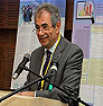Do medical spending and income reduce the prevalence of human immunodeficiency virus and tuberculosis? A study on Sub-Saharan Africa
Abstract
Several countries in sub-Saharan Africa (SSA) suffer from economic hardship and high unemployment rates; furthermore, this region has higher rates of human immunodeficiency virus (HIV) and tuberculosis (TB). This study examined the relationships between HIV and TB, income, and total medical spending and its components, private and public healthcare expenditure, for 41 SSA countries. Random and fixed-effects models were utilized in this study to explore relationships by studying time series and cross-sectional panel data obtained from the World Bank. Results demonstrated that there is a positive relationship between HIV and unemployment and a negative relationship with income and medical spending. We also observed that, when private and public medical expenditures are compared, private medical expenditures alleviate the HIV epidemic. Considering the association with TB, income, total, and its components, private and public medical expenditures are negatively related. Since prevention of such life-threatening diseases as HIV and TB becomes vital to find remedies for, there is a need for more government initiatives, including job creation, increased productivity, and increased income levels, which can be seen as preconditions in fighting and controlling HIV and TB.
References
[1]World Health Organization. Global Health Sector Response to HIV, 2000-2015: Focus on Innovations in Africa. Available online: http://www.who.int/hiv/pub/progressreports/2015-progress-report/en/ (accessed on 6 October 2016).
[2]World Health Organization. Accelerating Progress on HIV, Tuberculosis, Malaria, Hepatitis and Neglected Tropical Diseases. A New Agenda for 2016-2030. Available online: http://www.who.int/about/structure/organigram/htm/progress-hiv-tb-malaria-ntd/en/ (accessed on 6 October 2016).
[3]Sambo L, Kirigia J, Orem J. Health financing in the African Region: 2000–2009 data analysis. International Archives of Medicine. 2013; 6(1): 10. doi: 10.1186/1755-7682-6-10
[4]Amico P, Aran C, Avila C. HIV Spending as a Share of Total Health Expenditure: An Analysis of Regional Variation in a Multi-Country Study. PLoS ONE. 2010; 5(9): e12997. doi: 10.1371/journal.pone.0012997
[5]Kakaire T, Schlech W, Coutinho A, et al. The future of financing for HIV services in Uganda and the wider sub-Saharan Africa region: should we ask patients to contribute to the cost of their care? BMC Public Health. 2016; 16(1). doi: 10.1186/s12889-016-3573-0
[6]Arán-Matero D, Amico P, Arán-Fernandez C, et al. Levels of Spending and Resource Allocation to HIV Programs and Services in Latin America and the Caribbean. PLoS ONE. 2011; 6(7): e22373. doi: 10.1371/journal.pone.0022373
[7]Izazola-Licea JA, Wiegelmann J, Arán C, et al. Financing the Response to HIV in Low-Income and Middle-Income Countries. JAIDS Journal of Acquired Immune Deficiency Syndromes. 2009; 52(Supplement 2): S119-S126. doi: 10.1097/qai.0b013e3181baeeda
[8]Ávila C, Loncar D, Amico P, et al. Determinants of government HIV/AIDS financing: a 10-year trend analysis from 125 low- and middle-income countries. BMC Public Health. 2013; 13(1). doi: 10.1186/1471-2458-13-673
[9]Zeng W, Shepard DS, Chilingerian J, et al. How much can we gain from improved efficiency? An examination of performance of national HIV/AIDS programs and its determinants in low- and middle-income countries. BMC Health Services Research. 2012; 12(1). doi: 10.1186/1472-6963-12-74
[10]Yogo UT, Mallaye D. Health Aid and Health Improvement in Sub‐Saharan Africa: Accounting for the Heterogeneity Between Stable States and Post‐Conflict States. Journal of International Development. 2014; 27(7): 1178-1196. doi: 10.1002/jid.3034
[11]Peiffer CA, Boussalis C. Foreign Assistance and the Struggle Against HIV/AIDS in the Developing World. Journal of Development Studies. 2010; 46(3): 556-573. doi: 10.1080/00220380903151041
[12]Farag M, Nandakumar AK, Wallack SS, et al. Does Funding From Donors Displace Government Spending For Health In Developing Countries? Health Affairs. 2009; 28(4): 1045-1055. doi: 10.1377/hlthaff.28.4.1045
[13]Crémieux PY, Ouellette P, Pilon C. Health care spending as determinants of health outcomes. Health economics. 1999; 8(7): 627-639. doi: 10.1002/(SICI)1099-1050(199911)8:7<627::AID-HEC474>3.0.CO;2-8
[14]Bein MA, Unlucan D, Olowu G, et al. Healthcare spending and health outcomes: evidence from selected East African countries. African Health Sciences. 2017; 17(1): 247. doi: 10.4314/ahs.v17i1.30
[15]Gani A. Health care financing and health outcomes in Pacific Island countries. Health Policy and Planning. 2008; 24(1): 72-81. doi: 10.1093/heapol/czn044
[16]Bredenkamp C, Mendola M, Gragnolati M. Catastrophic and impoverishing effects of health expenditure: new evidence from the Western Balkans. Health Policy and Planning. 2010; 26(4): 349-356. doi: 10.1093/heapol/czq070
[17]Filmer D, Pritchett L. The impact of public spending on health: does money matter? Social Science & Medicine. 2000; 50(10): 1517-1518. doi: 10.1016/S0277-9536(99)00489-X
[18]Maruthappu M, Da Zhou C, Williams C, et al. Unemployment, public–sector health care expenditure and HIV mortality: An analysis of 74 countries, 1981–2009. Journal of Global Health. 2015; 5(1). doi: 10.7189/jogh.05.010403
[19]Adedigba MA, Naidoo S, Abegunde A, et al. The economic burden of HIV and AIDS on households in Nigeria. African Journal of AIDS Research. 2009; 8(1): 107-114. doi: 10.2989/ajar.2009.8.1.11.724
[20]Steinert JI, Cluver L, Melendez-Torres GJ, et al. Relationships between poverty and AIDS Illness in South Africa: an investigation of urban and rural households in KwaZulu-Natal. Global Public Health. 2016; 12(9): 1183-1199. doi: 10.1080/17441692.2016.1187191
[21]Rahman T. Determinants of public health expenditure: some evidence from Indian states. Applied Economics Letters. 2008; 15(11): 853-857. doi: 10.1080/13504850600770970
[22]Wooldridge JM. Introductory Econometrics: A Modern Approach, 3rd ed. South-Western Cengage Learning International; 2006.
[23]Agyei-Mensah S. Poverty and HIV prevalence in Ghana: a geographical perspective. GeoJournal. 2006; 66(4): 311-324. doi: 10.1007/s10708-006-9003-6
[24]Long D, Deane K. Wealthy and healthy? New evidence on the relationship between wealth and HIV vulnerability in Tanzania. Review of African Political Economy. 2015; 42(145). doi: 10.1080/03056244.2015.1064817
[25]De Wet N. Gendered differences in AIDS and AIDS-related cause of death among youth with secondary education in South Africa, 2009–2011. SAHARA-J: Journal of Social Aspects of HIV/AIDS. 2016; 13(1): 170-177. doi: 10.1080/17290376.2016.1242434
[26]Karim SSA, Churchyard GJ, Karim QA, Lawn SD. HIV infection and tuberculosis in South Africa: an urgent need to escalate the public health response. The Lancet. 2009; 374(9693): 921-933. doi: 10.1016/S0140-6736(09)60916-8
[27]Nyindo M. Complementary factors contributing to the rapid spread of HIV-I in sub-Saharan Africa: a review. East African medical journal. 2005; 82(1).
Copyright (c) 2024 Murad A. Bein, Galip E. Erdil

This work is licensed under a Creative Commons Attribution 4.0 International License.







.jpg)
.jpg)

